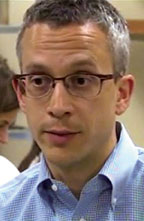
 Study shows how PrEP can protect heterosexual couples
Study shows how PrEP can protect heterosexual couples
Jared M. Baeten, M.D., Professor of Epidemiology, University of Washington, Seattle
For serodiscordant couples, those in which one partner is HIV positive, emphasis must be placed on ensuring that the HIV-negative partner avoids HIV infection. A new study shows that pre-exposure prophylaxis (PrEP) can be crucial to achieving that goal.
Researchers from the University of Washington presented the results of a study called the Partners Demonstration Project during the 2015 Conference on Retroviruses and Opportunistic Infections (CROI 2015) in February. The study was one of several that have recently produced exciting findings about the use of PrEP and how it can help to further curb the HIV epidemic.
Since it’s known that both antiretroviral therapy (ART) and PrEP substantially reduce HIV risk, the Partners Demonstration Project sought to look at how these tools could be used together in couples who are at high risk of infection.
Treatment Methods Varied
The project took place in Kenya and Uganda between November 2012 and August 2014. Approximately 1,015 (presumably) heterosexual couples enrolled in the study.
Not all couples received the same treatment. In some cases the infected partner received ART and the noninfected partner received PrEP. In other cases, only one of the two partners received treatment: Either the noninfected partner received PrEP or the infected partner received ART.
Jared M. Baeten, M.D., professor of epidemiology at the University of Washington in Seattle, announced the study results at CROI 2015 and explained that the strategy of using “PrEP as a bridge to ART” involves the noninfected partner taking PrEP until the infected partner has received ART for six months. The six-month mark is significant because it is believed that by then, viral suppression will have been reached. When viral suppression is achieved, one has a very low level of HIV in the blood, making transmission of the virus much less likely.
“PrEP as a bridge to ART is
not only feasible in this high-risk population but highly effective in preventing HIV transmission,” said Dr. Baeten.
Study participants saw a 96 percent reduced risk of HIV infection.
Good News for Couples
The results of the study are welcome news for straight couples in which one partner is HIV positive. “These findings suggest that for heterosexual discordant couples, both PrEP and antiretroviral treatment can play an important role in HIV prevention—separately and in combination,” said Jonathan Mermin, M.D., MPH, director of the Centers for Disease Control and Prevention’s National Center for HIV/AIDS, Viral Hepatitis, STD and TB Prevention, in a statement.
Researchers noted that the study also shows that not all couples have to take the same approach to preventing HIV infection. After all, with some couples, the HIV-negative partner started taking PrEP before the HIV-positive partner felt ready to begin taking antiretrovirals.
“In this situation where we had this tailored approach, not one size fits all, but depending on the needs of that couple, the level of transmission was virtually nil,” said Carl W. Dieffenbach, Ph.D., director of the Division of AIDS at the National Institute of Health’s National Institute of Allergy and Infectious Diseases. “How we take this now and scale it within communities and within nations is a very important next step.”
Although some studies focus on one particular demographic group, the results of the Partners Demonstration Project can provide insight into HIV prevention strategies for different segments of the population, researchers said. “Our results also speak to the potential for HIV protection from integrated PrEP and ART in other high-risk populations . . . including men who have sex with men, and women at risk,” said Dr. Baeten.
The study also calls attention to the need to look at how various tools can make a bigger impact when used together. “These results underscore the potential impact of combining the increasing number of powerful HIV prevention options to slow the HIV epidemic,” Dr. Mermin said.
Tamara E. Holmes is a Washington, D.C.-based journalist who writes about health, wealth and personal growth.


Be the first to comment